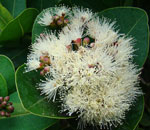|
This is probably one of the most well
known of our local trees. It occurs all along our coastal belt in damp
areas along streams and on the edges of marshes.
As
children and even adults we have all at one time or another had a taste
of the swollen ripe black fruits. The taste is slightly acidic but
refreshing. Just as oranges or litchis have better tasting varieties
the umDoni has better fruiting and flavoured specimens.
The
fruit-eating birds and Monkeys are all over the trees when the fruits
are ripe in the late summer. In the evenings you will find the shy
antelope like Duiker and Bushbuck even Nyala further north, of course
don’t forget the Bushpig, moving in at sunset and during the hours of
darkness to feast on the fallen fruits.
|

Click on
the Image
|
In the natural
conditions of swamps umDoni trees form a dominant feature of swamp
forests. The trees are often festooned with epiphytic orchids that
provide another dimension of interest for the keen observer.
This is one of the prime pioneer species that I would plant in the
stream areas that need to be protected from soil erosion in the
sugarcane belt of KZN.
These trees can withstand wind and salt spray and still survive.
Drought is a problem and to get the best results always have the tree
with its roots in a damp sunny spot. In Zululand the trees live on the
wind swept grasslands of the eastern shores of Lake St. Lucia and have
a dwarfed and windswept look about them.
All in all this species is a real survivor of our continent even
surviving the periodic fires that sweep through the grasslands that
make up much of its habitat.
To grow this species take fresh fruits, clean off the fleshy outer
covering and sow the greenish looking seeds in damp well drained soil
or sand. Once the seeds germinate after about 2-3 weeks they can be
pricked out into small containers to begin their new lives. Always grow
Waterberry trees in as much sunlight as possible to harden the young
trees up and encourage vigorous new growth.
A great evergreen garden tree, with its rounded canopy, that will give
great pleasure in your garden.
